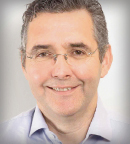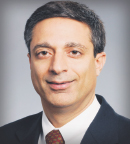The OPTIMUM/MUKnine1 and FORTE2 updates were discussed at the 2021 ASCO Annual Meeting by Gordon Cook, MBChB, PhD, Clinical Director of the National Institute for Health Research In Vitro Diagnostics Cooperative and the Clinical Trials Unit in Hematology of the University of Leeds, United Kingdom. The studies, he said, offer “food for thought” and “give us hope” that newly diagnosed patients with high-risk myeloma may achieve better outcomes.

Gordon Cook, MBChB, PhD

Sagar Lonial, MD
Sagar Lonial, MD, also weighed in on the findings: “FORTE speaks to the role of KRd [carfilzomib, lenalidomide, dexamethasone] in the high-risk population” and validates the benefit of transplantation. Dr. Lonial is Professor and Chair of Hematology and Medical Oncology and the Anne and Bernard Gray Family Chair in Cancer at Emory University School of Medicine, Atlanta, and Chief Medical Office of the Winship Cancer Institute. “The transplant arm of KRd plus ASCT [autologous stem cell transplantation] was clearly better, whether you have standard-risk, high-risk, or double-hit disease,” Dr. Lonial noted. “Patients do worse if you don’t offer transplantation.”
Dr. Lonial emphasized that, of the three regimens studied in FORTE, the best results were demonstrated with KRd and ASCT and the worst were seen with KCd [carfilzomib, cyclophosphamide, dexamethasone] and ASCT. He said the message is clear: “You should not be using cyclophosphamide in the induction setting if you have access to an immunomodulatory drug/proteasome inhibitor combination for newly diagnosed mutiple myeloma.”
The study showed promising results in high-risk (and ultra-high–risk) disease. FORTE now has demonstrated that, except for patients with amp(1q), the combination of a proteasome inhibitor and immunomodulatory agent, followed by ASCT, yields superior progression-free survival in high-risk patients across del(17p), t(4;14), and gain(1q) abnormalities. “This gives us hope…. It is an example of the high-risk readout being a prognostic biomarker that has not yet been utilized for predictive biomarker capability.... Nonetheless, this helps inform future study designs,” Dr. Cook said.
As for maintenance, Dr. Lonial commented that progression-free survival from the second randomization was “quite striking,” especially in patients with high-risk and double-hit disease. These phase II findings support the Emory practice of using carfilzomib plus lenalidomide in high-risk patients, he said, However, longer follow-up will be needed to determine whether the addition of carfilzomib will truly improve long-term outcomes in standard-risk patients.
Clinical Key: Sustained MRD Negativity
Measurable residual disease (MRD) negativity was sustained at 1 year in about half the patients with high-risk and double-hit disease in FORTE, which is an important observation, Dr. Lonial continued. “Higher MRD is great, but if it lasts a week, it’s meaningless. Showing sustained MRD negativity at two time points, 1 year apart, is very important…and is a harbinger of progression-free survival if further sustained.”
From the OPTIMUM/MUKnine trial, it also now is clear that genetic risk stratification can be determined in a centralized lab and essentially “in real time.” This will allow clinicians to tailor treatments accordingly, though the best means of identifying high-risk patients is still being ascertained, Dr. Cook said.
The study also showed that a dose-dense delivery platform is feasible, with acceptable safety and high rates of complete response (50%) and MRD negativity (82%) in a phase II setting. “From the early cut of the data, we saw that using dose-dense delivery for patients at molecular high risk can drive up MRD negativity,” explained Dr. Cook. “Of course, we know from other studies that achieving MRD negativity in high-risk patients still makes them vulnerable to poor durability of response, which is key…. It’s too early to read out durability in this context.”
Evolving Therapeutic Landscape
Dr. Cook acknowledged that although progression-free survival is improved with the regimens in these trials, it is still shorter for high-risk patients than for standard-risk patients. Therefore, optimal treatment of this population remains an unmet need.
“The therapeutic landscape continues to evolve and expand at an exponential rate,” commented Dr. Cook, “and the challenge facing physicians is to deliver the right drug to the right patient in the right risk group: knowing how to sequence the exposure to these new drugs, which group may benefit from which drug/drug sequence, and how to measure the optimal exposure in a setting of continuous treatment. For most global health economies, there is also a financial challenge.”
DISCLOSURE: Dr. Cook has received honoraria from Amgen, Bristol Myers Squibb, Celgene, Janssen-Cilag, Karyopharm Therapeutics, Oncopeptides, and Takeda; has served as a consultant or advisor to Amgen, Bristol Myers Squibb, Janssen, Karyopharm Therapeutics, Oncopeptides, and Takeda; has participated in a speakers bureau for Amgen, Janssen-Cilag, Jazz Pharmaceuticals, and Takeda; has received institutional research funding from Celgene and Takeda; and has been reimbursed for travel, accommodations, or other expenses by Takeda. Dr. Lonial holds stock or other ownership interests in TG Therapeutics; has served as a consultant or advisor to AbbVie, Amgen, Bristol Myers Squibb, Celgene, GlaxoSmithKline, Janssen Oncology, Merck, Novartis, Sanofi, and Takeda; has received research funding from Bristol Myers Squibb, Celgene, and Takeda; and has held other relationships with TG Therapeutics.
REFERENCES
1. Kaiser MF, Hall A, Walker K, et al: Depth of response and minimal residual disease status in ultra high-risk multiple myeloma and plasma cell leukemia treated with daratumumab, bortezomib, lenalidomide, cyclophosphamide and dexamethasone: Results of the UK OPTIMUM/MUKnine trial. 2021 ASCO Annual Meeting. Abstract 8001. Presented June 8, 2021.
2. Gay F, Mina R, Rota-Scalabrini D, et al: Carfilzomib-based induction/consolidation with or without autologous transplant followed by lenalidomide or carfilzomib-lenalidomide maintenance: Efficacy in high-risk patients. 2021 ASCO Annual Meeting. Abstract 8002. Presented June 8, 2021.

